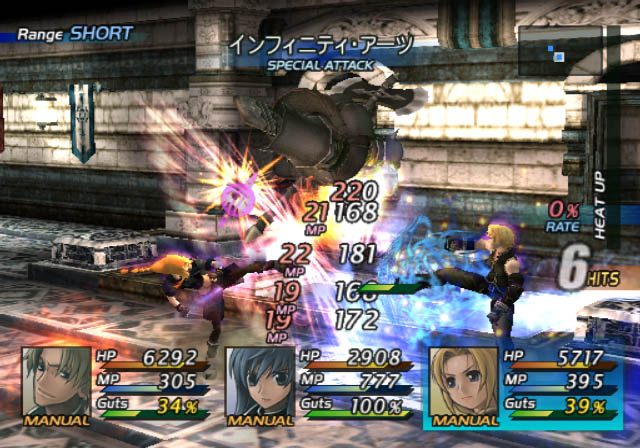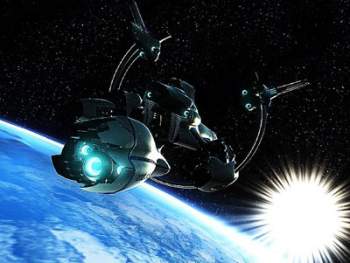|
|

|
PLATFORM
|
PS2
|
BATTLE SYSTEM
|

|
INTERACTION
|

|
ORIGINALITY
|

|
STORY
|

|
MUSIC & SOUND
|

|
VISUALS
|

|
CHALLENGE
|
Adjustable
|
COMPLETION TIME
|
40+ Hours
|
|
OVERALL

|
+ Flawed but fun battle system.
+ The Game Dictionary.
+ Decent aurals/visuals.
- Some mechanisms aren't explained very well.
- Poor spacing of save points.
- Black screens of death.
|
Click here for scoring definitions
|
|
|
Soon after Enix released Star Ocean: Till the End of Time in Japan to criticism that it was buggy, they merged with Square, a company that had only recently begun its nasty habit of releasing so-called "international" Director's Cut versions of its games, such as Final Fantasy X and its direct sequel. Whether to assuage criticism of the game's buggy nature or due to Square infecting the remnants of Enix with the habit, the newly-formed Square-Enix released an updated Director's Cut of Star Ocean 3 in Japan in 2004, surprisingly breaking its tradition of not allowing its Director's Cuts beyond Japan and exporting it to North America the same year. Was the enhanced version worth the wait?
Star Ocean 3 begins with protagonist Fayt Leingod vacationing with his parents and childhood friend Sophia Esteed on the resort planet Hyda IV. Following a scene where a circus troupe girl, Peppita Rossetti, for some reason autographs her original Japanese name on the back of Fayt's shirt, and an attack by Romulans the Vendeeni, Fayt finds himself on the sixteenth-century-civilization planet of Vanguard III, where he has a run-in with Cliff Fittir and his assistant Mirage, members of an anti-Federation organization known as Quark. Afterward, they go to a seventeenth-century-civilization planet of Elicoor II, entangling themselves in its wars in violation of the Prime Directive Underdeveloped Planet Protection Pact (UP3).
Most of the game's events are spent on Elicoor II, and throughout their quest, Fayt and company will encounter plenty of enemies on fields separating towns and dungeons, not to mention the dungeons themselves. In a shift from previous Star Oceans, monsters are now visible, although the third installment unfortunately doesn't follow the EarthBound formula of instant victories against weak foes and enemies running away if his party is powerful enough. Ambush attacks by the enemy are also oddly frequent regardless of how Fayt contacts them, with no opportunity for the player to ambush the enemy in return.
 Battles are fun
Battles are fun
|
|
Battles themselves, however, aren't half-bad, being real-time like in previous Star Oceans. New is each of the three active characters' Fury gauges, which max out at 100% and bottom out at 0%, with the latter amount being initial if the enemy ambushes the player. Executing commands like weak and strong-type attacks consumes Fury, which refills completely after about a second or so when a character stands still. There's also a rochambeau formula where weak-type attacks can cancel the enemy's strong-type attacks, strong-type attacks break through maxed-out enemy Fury gauges, and a character's maxed out Fury gauge reflects the enemy's weak-type attacks and triggers an anti-attack aura that can do things like stun the enemy.
Given the unpredictability of enemy Fury gauges, however, it's far easier to spam coups de grace, special skills that consume part of the user's HP (magicians can also cast normal MP-consuming magic), against foes, with a weak-type coup de grace followed by a strong-type coup de grace (players can set up coups de grace and support skills outside battle, with each consuming a certain amount of Capacity Points) resulting in a "cancel bonus" that augments damage, a useful mechanism oddly not explained in the instruction book at all. Once the player wins a battle, they receive some money, occasional items, and experience for all characters who survived the fight (with characters able to die when they reach zero MP, as they do when they reach zero HP). When characters level, they may learn new skills, and receive Skill Points the player can use outside battle to increase their HP, MP, Attack, and Defense.
As the player's characters hammer the enemy, a bonus gauge fills up, with the first triggered bonus depending upon the type of attack that caused it to fill completely (for instance, a weak-type attack will result in the useful Triple EXP bonus). As the player fights more special bonus battles, more bonuses may come, such as increased money, an increased chance of item drops, and more HP/MP recovery after the battle. However, the bonus gauge breaks when the enemy lands a critical attack on the controlled character, he/she dies, or when the player quits the game/reloads a previous save file.
Another significant mechanism somewhat poorly-explained is the Invention system, where the player can hire inventors to work in workshops by giving them money or a special item; however, it would have been nice if the game kept track of inventor locations as well as the requirements to hire them. Inventors will occasionally invent new items that will eventually go to sale in shops as the player progresses through the game, although the player's characters can try their hand at inventing, as well, with workshops having three assembly lines that can contain up to three inventors each.
 You won't be seeing this often.
You won't be seeing this often.
|
|
After placing inventors, the player selects a kind of item to invent and receives the option of inventing something new or enhancing a current item, which requires special materials; however, if the player chooses to invent a new item, the game randomly selects a price for their characters to work with, forcing them to button-mash to get the price they want to work with, which can take anywhere from a few seconds to a few minutes. Why not save some time and annoyance by letting players manually select invention prices? Furthermore, the game neglects to mention that different ranges of prices correspond to different items, with certain price ranges unfortunately overlapping.
Once the player is satisfied with the setup of the inventors and the prices they work with, they can begin the invention process, with gauges indicating item quality depleting the longer the invention is taking, and the process ending when the quality gauges empty or the player runs out of money. It would have been nice to speed up the process and see what the inventors are making if they're successful (with the process able to continue even after they invent something). All in all, the invention system is the low point of the game mechanics, though since it can potentially break the game's balance, its obscurity is understandable, and battles themselves provide plenty of entertainment.
Interaction, however, leaves far more room for improvement. World exploration is similar to that in the original Star Ocean, with vast fields connecting towns and dungeons, sure to disappoint fans of unrealistic donut-shaped overworlds where the protagonist becomes a forty-foot giant. This isn't a bad thing, although some form of transportation between towns and means to exit dungeons other than Fayt's feet would have definitely been welcome. The game also provides bunny statues sellable for a fair price for completion of each field and dungeon's automap, although doing so is ridiculously hard at times, ironic considering the weak rewards for doing so.
Other areas of control don't fare any better, such as the frequently-abysmal spacing of save points, a burden considering the occasional "black screen of death" where the game will either hang up for some time (with an occasional "reading data from disc" message), or freeze completely. There is also occasional vague direction on how to advance the main storyline, and one-stop shopping, given the endless varieties of items the player can purchase, would have been welcome, as well. The menus, however, are easily navigable, and players can tell if equipment will increase or decrease stats before buying it, but interaction overall could have been far better.
Star Ocean 3 is in essence an amalgamation of elements borrowed from its predecessors, such as real-time combat, item creation, and plenty of time spent on underdeveloped planets, although the gameplay has plenty of unique tweaks such as death when a character reaches zero MP, anti-attack auras, and weak/strong attacks/coups de grace; the idea of HP-consumption for special skills, moreover, is filched from the Lennus titles. The plot also borrows heavily from Star Trek and to some extent The Matrix films, and ultimately, the third installment is a mildly-inventive title.
 Animate statues with good balance
Animate statues with good balance
|
|
Despite the horror stories, Star Ocean 3's plot actually isn't that bad, with the Game Dictionary in particular being a good idea (despite spoiling some of the plot ahead of time), and a decently-fleshed-out cast of characters. Much controversy has surrounded the "big plot twist" towards the end, although there are in reality two major plot twists, neither of which are bad at all, at least in this reviewer's opinion. The hour-plus ending, moreover, provides closure for Fayt and all acquired teammates (with potential variations), as well as a general sense of accomplishment for the player. Overall, the story definitely isn't the best the RPG genre has ever told, given the very little time spent in the titular Star Ocean, although it could have definitely been far worse.
Musically, Star Ocean 3 fares better, with Motoi Sakuraba again lending his talents, what with plenty of solid town, dungeon, and battle themes, despite committing the usual sin of composing only one regular battle theme that gets old after a while. The cutscene voice acting is okay, although some voices, such as those for Farleen, Peppita, and her circus troupe, are aural torture. Moreover, the typical Japanese convention of characters shouting the names of their skills in battle doesn't translate well to the Anglophone world, and worse yet, many enemies have voices, most of which are simply atrocious; mercifully, players can turn off battle voices. All in all, a decent-sounding game.
Star Ocean 3 fares just as well visually, using an anime style similar to the Xenosaga trilogy, and even being wide-screen compatible. Most of the futuristic environments and player character models look decent, although the texturing of primitive environs looks bland at times, and there is a noticeable difference between the quality of player character models and those of many NPC models. Still, the game is mostly easy on the eyes.
Finally, completing the third installment without doing sidequests takes as little as forty hours, although post-game content and collecting every Battle Trophy by fulfilling certain conditions in battle (only available on difficulties other than Earth, the easiest setting), can push this to over a hundred hours. Overall, Star Ocean: Till the End of Time, given its problems like the obscurity of some of its mechanisms and occasional freezes, is perhaps the weakest iteration of the series (though this reviewer hasn't yet played the fourth installment), but it's still an enjoyable game, given its fun battle system and decent music and visuals, and is certainly worth a look by series fans and those new to the franchise.
Review Archives
|









